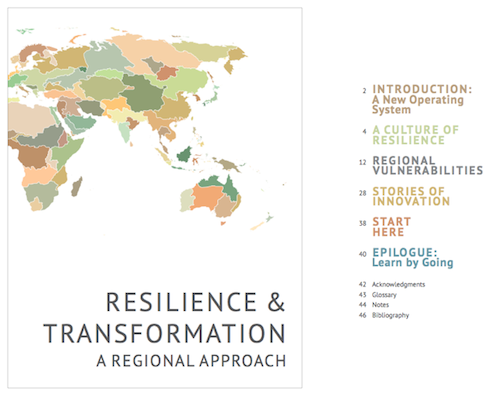
With the triennial Resilience 2014 conference next month, I was looking back at this post I wrote after the 2011 conference. Fair to say, I think, that these statements still hold: resilience is increasingly discussed yet often narrowly understood.
As we wrote in the title of the publication above, the resilience of social and ecological systems is best understood in a dynamic relationship with transformation. No resilience without transformation. Yet, as Katrina Brown recently noted, resilience is “often interpreted as means of staying the same, of resisting change.”
Here’s my post of April 2011:
The idea of resilience, increasingly discussed, remains narrowly understood.
Increasingly discussed: Google shows a sharp uptick in news references since the beginning of the year.
Narrowly understood: That’s the finding of a media content analysis presented at the Resilience 2011 conference. From the abstract (pdf) by Anne Leitch and Erin Bohensky:
We use content analysis of Australian news media articles from 2005-2010 to examine resilience concepts associated with natural disasters. Articles analyzed included those that mentioned resilience in conjunction with disasters such as bushfires, floods or drought, and discuss dealing with, recovering from, or preparing for such events.
Preliminary analysis suggests that the public construction of the resilience concept is diverse but narrow with fewer dimensions than the theoretical basis of the concept used by the Resilience Alliance though some similarities are evident. Common themes associated with resilience in the news media include the ability to return to a ‘new normal’, community cohesion, community preparedness, experience and learning.
Here is a recent – and memorable – media reference I saw, from the Washington Post:
“Think of resilience in terms of the old Timex commercial,” said Jack Hayes, director of the National Earthquake Hazard Reduction Program. “It can take a licking and keep on ticking.”
This take-a-licking-keep-on-ticking quality of resilience, is described by Resilience Alliance scientists as “persistence” – and as one of three attributes of resilience thinking. The other two are adaptability and transformability.
From a 2010 paper by Carl Folke and coauthors, “Resilience Thinking: Integrating Resilience, Adaptability and Transformability“:
In a nutshell, resilience thinking focuses on three aspects of social–ecological systems (SES): resilience as persistence, adaptability and transformability. … Adaptability is a part of resilience. Adaptability is the capacity of a SES to adjust its responses to changing external drivers and internal processes and thereby allow for development within the current stability domain, along the current trajectory.
Transformability is the capacity to create new stability domains for development, a new stability landscape, and cross thresholds into a new development trajectory. Deliberate transformation requires resilience thinking, first in assessing the relative merits of the current versus alternative, potentially more favorable stability domains, and second in fostering resilience of the new development trajectory, the new basin of attraction.
Illustrating the distinction between adaptation and transformation (from a 2006 paper: “A Handful of Heuristics and Some Propositions for Understanding Resilience in Social‐Ecological Systems”):
A change from sheep to goat production in rangelands in the face of changes in vegetation and markets is an example of adaptation in a livestock production system.
However, replacing ranching with wildlife‐based ecotourism and hunting and involving joint enterprises by combining properties to operate at larger scales, as in the central United States or in southern Africa, is an example of transformation.

